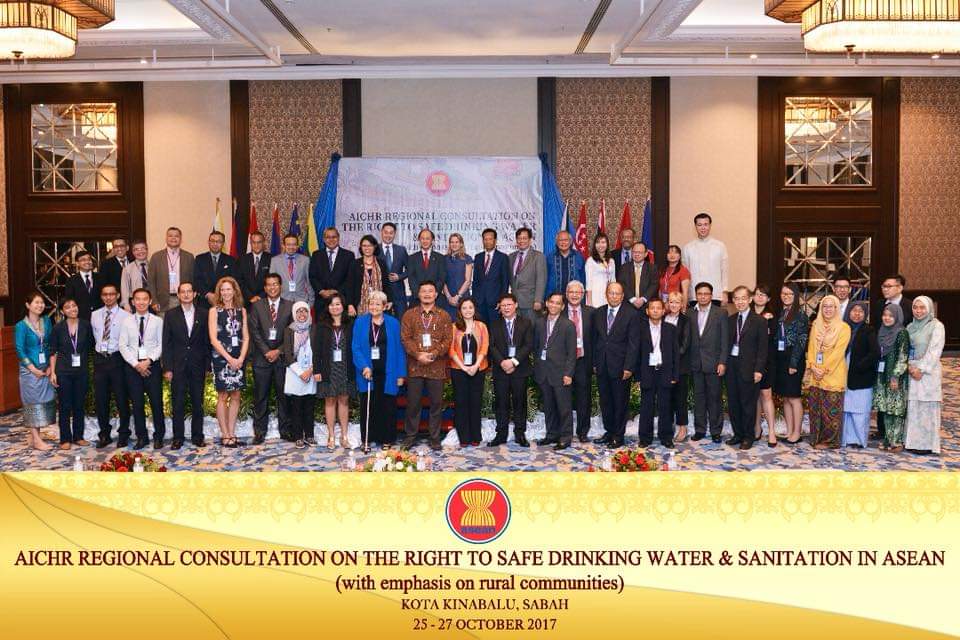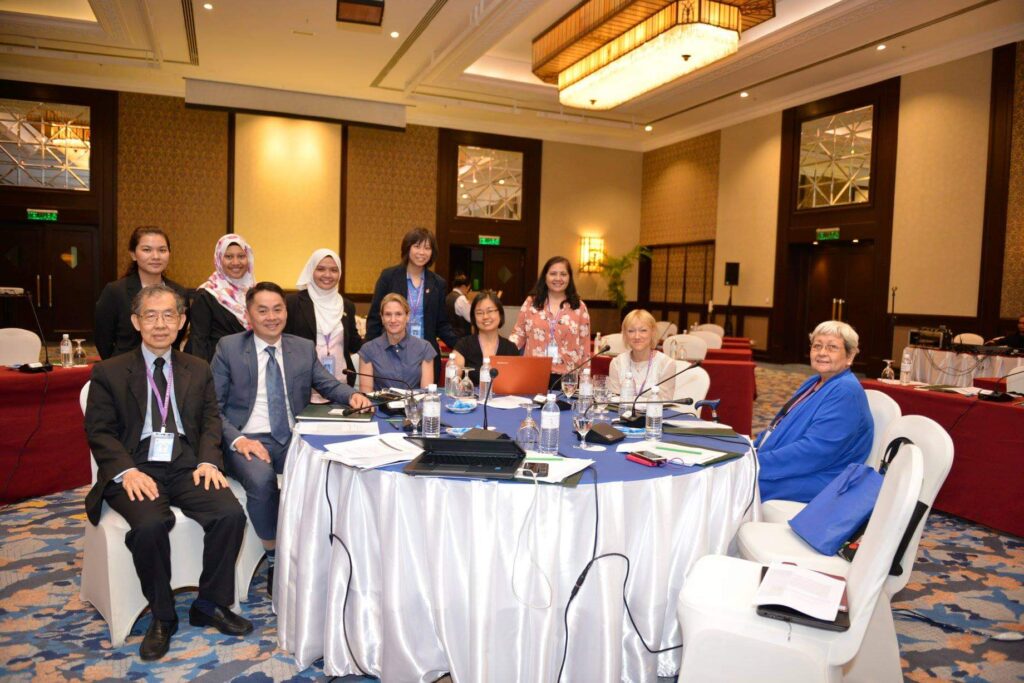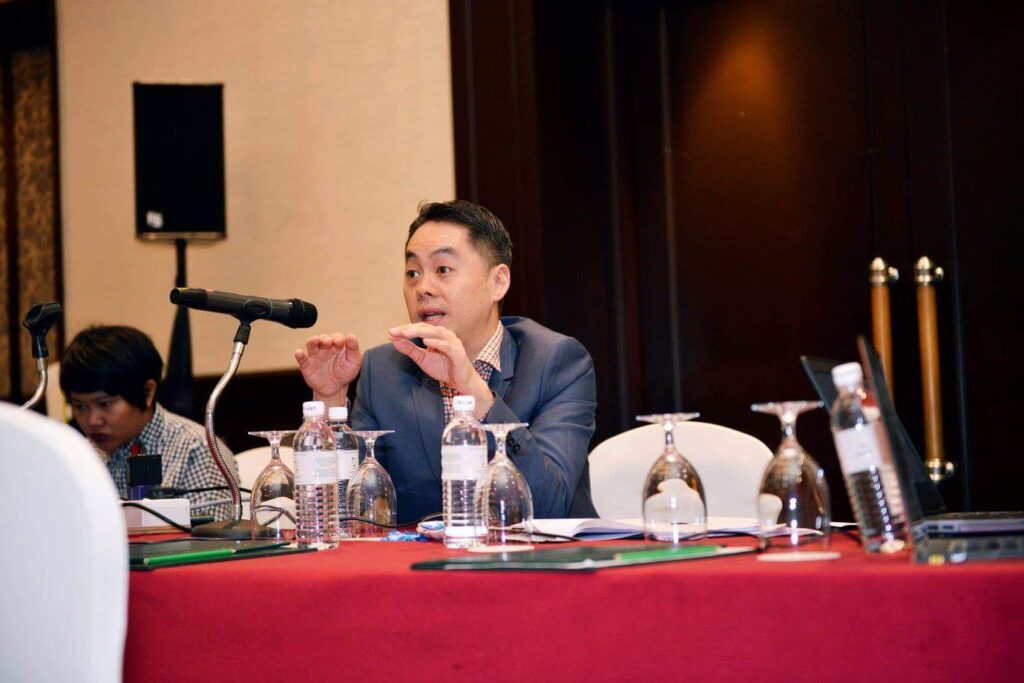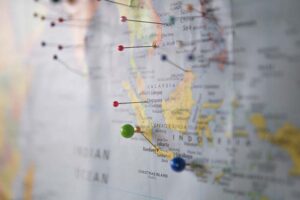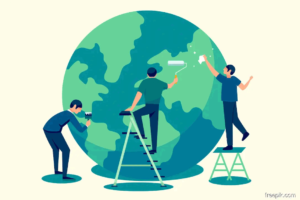I. Context
1. The Association of Southeast Asian Nations (ASEAN) adopted the ASEAN Human Rights Declaration (AHRD) on 18 November 2012. The Phnom Penh Statement on the Adoption of the ASEAN Human Rights Declaration affirms ASEAN Member States’ commitment to the full implementation of the AHRD to advance the promotion and protection of human rights in the region.
2. Following the “AICHR Regional Consultation on the Right to Safe Drinking Water and Sanitation in ASEAN (with emphasis on rural communities)” held in Sabah, Malaysia from 25 to 27 October 2017, and pursuant to our mandate in paragraphs 4.1, 4.3, 4.8, 4.9, 4.10 and 4.11 of our Terms of Reference, we set out in this Consultation Position Paper an elaboration of the right to safe drinking water and sanitation in the ASEAN context and an interpretative guide regarding Article 28(e) of the AHRD.
II. Introduction
3. Water is fundamental to the enjoyment by everyone, of an adequate standard of living including good health, nutritious food, sufficient housing and sustainable livelihood; and proper sanitation is essential for a life of dignity, health and well-being. While water resources are limited, demand has multiplied due to various factors such as rapid urbanisation, increasing populations, the adverse effects of climate change, industrialisation and economic growth, and the corresponding higher demands for food, energy and environmental security.
4. Social and economic development are closely dependent on water, and poverty is prevalent mostly in areas that face water shortage. Ill-health associated with deficits in water and sanitation undermines productivity and economic growth, and traps vulnerable households in cycles of poverty.
5. Water-related disease, caused by unsafe drinking water and the absence of proper sanitation facilities, are now among the leading causes of death across the developing world. Women and children from poor, low-income and rural communities are particularly vulnerable.
6. Article 28 of the AHRD states as follows:
Every person has the right to an adequate standard of living for himself or herself and his or her family including:
a. The right to adequate and affordable food, freedom from hunger and access to safe and nutritious food;
b. The right to clothing;
c. The right to adequate and affordable housing;
d. The right to medical care and necessary social service;
e. The right to safe drinking water and sanitation;
f. The right to a safe, clean and sustainable environment.
7. Article 28 enumerates a number of rights emanating from, and indispensable for, the realisation of the right to an adequate standard of living for every individual and his or her family. In particular, Article 28(e) uniquely recognises the right to safe drinking water and sanitation as part of the same right.
8. The importance of clean water and sanitation is also recognised in the United Nations Sustainable Development Goal (SDG) 6 of the 2030 Agenda for Sustainable Development, adopted by the UN General Assembly in 2015. Goal 6 seeks to achieve universal and equitable access to safe and affordable drinking water for all by 2030. It also seeks to achieve access to adequate and equitable sanitation and hygiene for all and end open defecation, paying special attention to the needs of women and girls and those in vulnerable situations.
9. ASEAN Member States have within the ASEAN framework agreed to, and undertaken, various initiatives to realise the right to safe drinking water and sanitation.
9.1 The “ASEAN Strategic Plan of Action on Water Resources Management” that was developed in 2005 complemented national-level efforts to address common challenges managing the region’s water resources, and included ways to improve access to safe drinking water and sanitation.1 Among the key targets was to reduce by 50% inadequate access to safe drinking water and sanitation by 2015. The Plan was administered by the ASEAN Working Group on Water Resources Management (AWGWRM) that was established under the auspices of the ASEAN Senior Officials on the Environment (ASOEN) that in turn reports to the ASEAN Ministerial Meeting on the Environment (AMME).
9.2 Under the “ASEAN Post-2015 Health Development Agenda”, any initiatives directly addressing safe drinking water and sanitation will be implemented under “Health Priority 11: Environmental Health and Health Impact Assessment” within “Health Cluster 2: Responding to All Hazards and Emerging Threats” for the years of 2016 to 2020. This Agenda falls to be implemented by the Senior Officials Meeting on Health Development (SOMHD) that reports to the ASEAN Health Ministers Meeting (AHMM).
9.3 In terms of uplifting the economic status of rural communities in the region, the “ASEAN Framework Action Plan on Rural Development and Poverty Eradication” for the years of 2016 to 2020 addresses the challenges of reducing poverty. The Framework Action Plan is being implemented by the Senior Officials Meeting on Rural Development and Poverty Eradication (SOMRDPE) that reports to the ASEAN Ministers Meeting on Rural Development and Poverty Eradication (AMMRDPE).
9.4 The 10-year ASEAN blueprint titled “ASEAN 2025: Forging Ahead Together” situates the importance of safe drinking water and sanitation as an element of development to build a sustainable and resilient ASEAN community by 2025.2
10. Further, all ASEAN Member States are parties to the Convention on the Elimination of All Forms of Discrimination Against Women (CEDAW), the Convention on the Rights of the Child (CRC) and the Convention on the Rights of Persons with Disabilities (CRPD). In different ways, these conventions affirm the right to water and access to the related benefits of water.3
III. Interpreting Article 28(e) of the AHRD
11. The following substantive elements of the right to safe drinking water and sanitation under Article 28(e) of the AHRD should be noted.
11.1 Availability
(a) Safe drinking water and proper sanitation should be available to all within the region.
(b) Safe drinking water should be available in sufficient quantities, and in continuous supply. The quantity of water available for each person should correspond with the guidelines by the World Health Organization (WHO).4
(c) Effective steps should be taken to ensure the availability of safe drinking water even in the face of current and future challenges such as floods, droughts, the rise in sea levels and any other natural or man-made causes, including the adverse effects of climate change.
(d) Regional cooperation and dialogue should be undertaken for the protection and sustainable management of water resources that are shared across national boundaries.
(e) Proper sanitation facilities should be available to all, including for those in rural or remote areas. The type of sanitation facilities to be made available may differ depending on cultural practices.
11.2 Accessibility
(f) Everyone should be able to access safe drinking water and proper sanitation without undue difficulties such as having to travel long distances or face dangerous situations.
(g) Safe drinking water and proper sanitation should be accessible to all without discrimination in law and in practice, based on any of the prohibited grounds especially in the case of the most vulnerable and marginalised sectors of the population.
(h) Accessibility includes the right to seek, receive and impart information concerning water issues. This includes information about the different types of water or sanitation systems available, and involves the right of everyone to be consulted and to effectively participate in decision-making processes regarding water and sanitation issues. Information indicators with regard to consultation and participation include public hearings, community assemblies and publication and distribution of relevant materials.
11.3 Affordability
(i) Safe drinking water and proper sanitation should be affordable for all. In countries where a tariff is charged, measures should be taken to ensure that the lowest income groups are still able to afford water and sanitation services. In this regard, there should be a regulatory body to ensure that prices are affordable, whether the service provider is public or private.
(j) The total costs including indirect costs associated with water and sanitation, should not threaten or impede the realisation of other rights and basic needs.
11.4 Acceptability
(k) Water should be of acceptable colour, odour and taste. This means that drinking water and sanitation facilities should be culturally acceptable, culturally appropriate and sensitive to gender, life-cycle and privacy requirements.
(l) To ensure the acceptability of water and sanitation facilities, there should be meaningful consultation involving the free, prior and informed consent of local communities in the preparation, construction and management of any water, sanitation and hygiene systems.
(m) There should be proper and effective feedback and redress mechanisms with authorities and regulatory bodies.
11.5 Quality
(n) The provision of safe drinking water of good quality involves a holistic approach, beginning with the protection of raw water sources, to the provision and maintenance of good infrastructure and equipment for treatment and distribution.
(o) The minimum standards for the quality of water should be in accordance with the WHO’s guidelines. Water-related diseases should be effectively prevented, controlled and treated.
(p) Essential hygienic sanitation facilities should be made available.
(q) There should be proper systems for the treatment of sewage and proper maintenance of such systems.
12. Similar to other human rights, there are three types of obligations in the realisation and implementation of the right to safe drinking water and sanitation: the obligations to respect, protect and fulfil. The examples below under each type of obligation are illustrative rather than exhaustive examples.
12.1 The Obligation to Respect
The obligation to respect includes State actors refraining from engaging, directly or indirectly, in any activity or practice that interferes, denies or limits access to adequate and safe drinking water and proper sanitation facilities, on the basis of equality and non-discrimination.
12.2 The Obligation to Protect
The obligation to protect requires State actors to prevent third parties from interfering in any way with the enjoyment of the right to safe drinking water and sanitation. Third parties include individuals, groups, corporations and other entities as well as agents acting under their authority. The obligation also includes adopting necessary and effective legislative and other measures to restrain third parties for example, from denying or compromising equal, affordable and physical access to sufficient and safe drinking water and proper sanitation.
12.3 The Obligation to Fulfil
The obligation to fulfil can be further disaggregated into the obligation to facilitate, promote and provide:
- The obligation to facilitate requires State actors, among others, to take positive steps to assist individuals and communities, without discrimination, to enjoy the right to safe drinking water and sanitation. Particular attention should be paid to women and children in vulnerable and marginalised groups.
- The obligation to promote includes taking steps to ensure that there is appropriate education and awareness concerning the hygienic use of drinking water and sanitation facilities, protection of water sources and methods to minimise water wastage. Active, free and meaningful participation should be encouraged as part of the exercise of the right.
- The obligation to provide safe drinking water and sanitation to individuals and groups who are unable, for reasons beyond their control, to provide for themselves by the means at their disposal. Examples of such situations include emergencies and crisis situations such as extreme weather events, disasters and conflicts.
The obligation to fulfil requires sufficient recognition of the right to safe drinking water and sanitation within the national, political and legal systems preferably by the adoption of legislation, a national water strategy framework and/or a plan of action to realise the right.
13. As Article 28(e) is an economic, social and cultural right, it should be read with Article 33. Therefore, ASEAN Member States should take steps, individually and through regional and international assistance and cooperation, especially economic and technical, to the maximum of its available resources, with a view to achieving progressively the full realisation of the economic, social and cultural rights recognised in the AHRD. Further, Article 28(e) is to be complemented by the right to development and its related facets contained in Articles 35 to 37 of the AHRD.
IV. Towards Implementing Good Practices and Developing a Common Approach on the Right to Safe Drinking Water and Sanitation in ASEAN
14. The positive and progressive work being undertaken by the sectoral bodies to deliver safe drinking water and sanitation to the peoples of this region is encouraging and should be supported.
15. Further measures that could be considered are noted as follows.
15.1 Indicators and Collection of Data
- Indicators on the availability, accessibility, affordability, acceptability and quality of safe drinking water and sanitation should be identified for data collection. This will assist in the evaluation of the access to safe drinking water and sanitation.
- Data to be collected should also be disaggregated based on the prohibited grounds of discrimination, including by gender, ethnicity, age and restrictions due to physical disabilities. This is to ensure that no particular group is being left behind in accessing safe drinking water and sanitation.
15.2 Communication and Dissemination of Information
- A regional programme of communication will augment efforts to share information and raise awareness regarding good hygiene practices and the right to safe drinking water and sanitation.
15.3 Integrated Water Resources Management
- The provision of safe drinking water and sanitation involves multiple sectors within government as well as the private sector and civil society organisations. Multi-sectoral coordination and engagement is thus key to ensuring that the right to safe drinking water and sanitation is realised. This coordination should be holistic and should extend coverage to include the protection of raw water resources, ensuring efficient treatment and distribution of water and waste water, and appropriate transboundary and water efficiency approaches.
15.4 Disaster Management
- A regional plan or guidelines to mitigate the negative impacts on the availability, accessibility, affordability, acceptability and quality of safe drinking water and sanitation during natural disasters or emergencies will augment efforts to build the capacity of first responders in the emergency services.
1 A new “ASEAN Strategic Plan of Action on the Environment” (ASPEN) for the years of 2016 to 2025 is due to be adopted. The proposed draft Plan has a strategic priority on Water Resources Management which includes a programme component on improving water quality and sanitation with the Senior Officials Meeting on Health Development (SOMHD) identified as a supporting sectoral body/partner.
2 See paragraphs C.2. item iii. and D.5., item iii. under the “ASEAN Socio-Cultural Community Blueprint 2025”.
3 Article 14(2) CEDAW, Article 24(2) CRC, and Article 28(a) CRPD.
4 WHO, “Guidelines for drinking water quality”, Vol. 1-3 (2nd ed). Geneva, 1991.
This proposed Position Paper was drafted by a team of experts led by Edmund as the Representative of Malaysia to the ASEAN Intergovernmental Commission of Human Rights (AICHR) from 2016 to 2018. Edmund presented the paper for adoption at the 26th Meeting of the AICHR held in Singapore from 24 to 26 January 2018 (Document 6.5aiii). The document was not adopted. It is also available in the AICHR Regional Consultation on the Right to Safe Drinking Water and Sanitation report (pp. 107-114) and at AICHR Malaysia Facebook page. Archived at https://perma.cc/45BG-5SDY.
